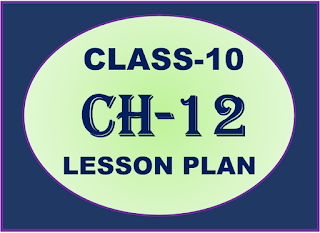Featured Posts
Lesson Plan Math Class X (Ch-12) | Surface Area and Volume
- Get link
- X
- Other Apps
TEACHER'S NAME : DINESH KUMAR | SCHOOL : RMB DAV CENTENARY PUBLIC SCHOOL NAWANSHAHR |
SUBJECT : MATHEMATICS | CLASS : X STANDARD BOARD : CBSE |
LESSON TOPIC / TITLE : CHAPTER 12: SURFACE AREA & VOLUME | ESTIMATED DURATION: This topic is divided into seven modules and are completed in twelve class meetings. |
- Perimeter and Area: Class VII
- Visualizing Solid Shapes: Class VII
- Visualizing Solid Shapes: Class VIII
- Mensuration: Class VIII
- Surface Areas and Volumes: Class IX
- Knowledge of unit conversion in mathematics
- Introduction of different types of solid figures and their comparison with the plane figures.
- Curved surface area, total surface area and volume of different solid figures.
- Surface area and volume of combination of solid figures.
- Method of converting one type of solid figure into another.
- Other mixed problems (combination of not more than two solid figures be taken)
- Different shapes of solid figures.
- All formulas and all important concepts related to the surface area of solid figures.
- All formulas and all important concepts related to the volume of solid figures.
- Solving the problems related to the solid figures.
- Students should also know the method of implementation of these formulas in simple and complex problems.
Teacher-Student Activities A. Warm-up Session
Begin the lesson by recalling the prior knowledge of students on the following topics:
- Surface area and volumes of cube and cuboid.
- Surface area and volume of cylinder and cone.
- Surface area and volume of sphere and hemi- sphere.
Recall the formulae to calculate the surface areas and the volumes of different basic solids.
Then, show different objects (or their images) that are made by the combination of different solids.
Teacher’s Explanation
Now teacher will provide complete explanations of all the formulas of the solid figures and ask the students to learn these formulas. Following solid figures need to be discussed here.
Surface area and volumes of cube and cuboid.
- Surface area and volume of cylinder.
- Surface area and volume of cone.
- Surface area and volume of sphere and hemi- sphere.
- Surface area and volume of Frustum of cone.
Combination of solid Figure.
Here we combine two or more solid figures and then find the surface area and volumes. Teacher will explain the method of finding the surface area and volume in the combination form.
Surface Areas and Volumes: Clay Activity
In this activity, students will calculate the surface areas and the volumes of the combination of solids.
In this activity, students with the help of clay make some solid figures and will calculate the change, if any, in the surface area and the volume of a solid when it is converted into different solid or multiple solids, either of the same or different shapes.
Explanation of the Activity
Divide the class into two groups. Bring some modeling clay to the classroom. Ask a group to shape the clay in any of the basic solids, such as cube, cuboid, cylinder and sphere. They need to take the required measurements and calculate the surface area and the volume of the solid that they have made. Now, the other group should break the solid and make numerous smaller solids from the clay. Then, they need to take the required measurements and calculate the surface area and the volume of the smaller shapes. Thereafter, ask both groups to analysis the relation between the surface area and the volume of the original solid and the new solids. Conduct a similar activity to prove that when the shape of a solid object is changed, its surface area changes but the volume remains constant. For this activity, change the original basic solid into the basic solid of a different shape.
For example, change a cube into a cylinder and compare the surface area and the volume of the cube with the cylinder.
Practice Work
Now teacher will explain the method of finding surface area and volumes by taking some examples from NCERT book. Teacher will also provide some questions to the students for practice
Practice with combination of solid figures
Teacher will also explain some other mixed problems [for the problems of combination of solid figures, not more than two solids be taken in combination] and should provide sufficient number of problems to the students for practice.
- Review questions given by the teacher.
- Students should prepare the presentation on the formulas of surface area and volumes of different solid figures.
- Solve NCERT problems with examples.
- Solve assignment given by the teacher.
PLEASE COMMENT BELOW
🙏
- Get link
- X
- Other Apps
Comments











Excellent
ReplyDeleteExcellent lesson plan
ReplyDelete